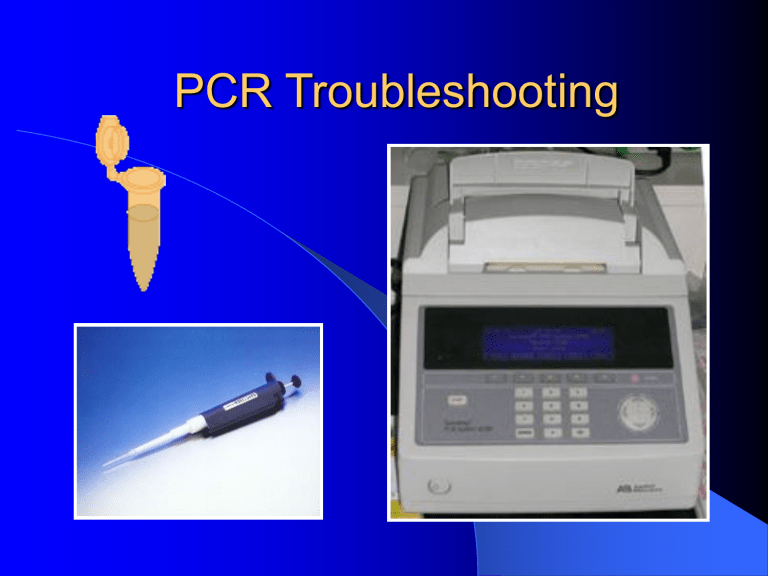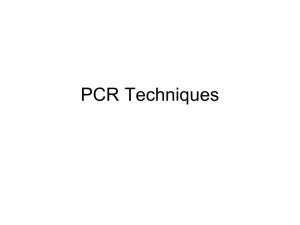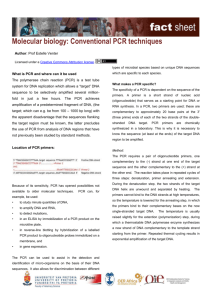PCR Troubleshooting

PCR Troubleshooting
Definition
PCR troubleshooting is a collection of techniques that alter
PCR reactions in order to achieve optimum PCR results http://academic.brooklyn.cuny.edu/biology/bio4fv/page/genetic-engin/pcr.html
Examples
PCR troubleshooting is used to…
Increase primer specificity
Increase quantity of PCR product
Increase quality of PCR product
Non-examples
PCR Troubleshooting is not used to…
Purify extracted DNA
Create recombinant DNA
Quantify DNA
Factors Influencing PCR Success
Tissue type used for DNA extraction
Quantity and quality of DNA
Length of the DNA fragment to be amplified
Primer specificity
Troubleshooting Strategies
Vary temperatures to optimize primer annealing
Cycle Temperatures
94 o 55 o - 72 o
94 o 48 o - 68 o
94 o 45 o - 65 o
94 o 40 o - 65 o
Reasoning
Well-matched primers
Poorly matched primers
“Fishing expedition”
Do these primers work?
Troubleshooting Strategies
Extend annealing time
Allows primers more time to find correct complement on template DNA
Can increase quantity of PCR product
But decreased primer specificity can lead to smeared bands
Troubleshooting Strategies
Ramping: Gradual increase from annealing to extension temperature
Taq polymerase has more time to extend amplification before the optimum extension temperature is reached
Locks primers into position for the final extension step
Troubleshooting Strategies
Other adjustable parameters:
Magnesium Chloride (MgCl
2
) concentration
DNA template concentration
dNTP concentration
Primer concentration
END
California State Chemistry Standards
Grade 8
6c. Living organisms have many different kinds of molecules…
Grades 9-12
6. Solutions are homogenous mixtures of two or more substances
7. Energy is exchanged or transformed in all chemical reactions and physical changes of matter
8. Chemical reaction rates depend on factors that influence the frequency of collision of reactant molecules
California State Biology Standards
Grade 7
2e. DNA is the genetic material of living organisms and is located in the chromosomes of each cell
3a. Genetic variation and environmental factors are causes of evolution and diversity of organisms
Grades 9-12
2. Mutation and sexual reproduction lead to genetic variation in a population
7. The frequency of an allele in a gene pool of a population depends on many factors and may be stable or unstable over time
California State
Investigation and Experimentation
Standards
Grade 7-8 a. Select and use appropriate tools and technology to perform tests, collect data, analyze relationships, and display data
Grades 9-12 c. Identify possible reasons for inconsistent results, such as sources of error or uncontrolled conditions d. Formulate explanations by using logic and evidence k. Recognize the cumulative nature of scientific evidence l. Analyze situations and solve problems that require combining and applying concepts from more than one area of science
National Standards
Grades 6-12
Content Standard A: Science as Inquiry
Content Standard C: Life Science
Content Standard E: Science and Technology











